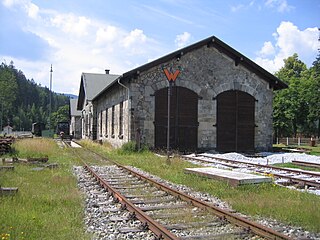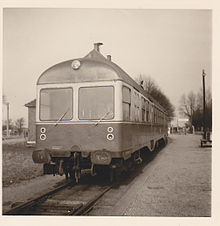
A railbus is a lightweight passenger railcar with an automotive engine. They shares many aspects of its construction with a bus, typically having a bus body and four wheels on a fixed base instead of on bogies. Originally designed and developed during the 1930s, railbuses have evolved into larger dimensions with characteristics similar in appearance to a light railcar, with the terms railcar and railbus often used interchangeably. Railbuses designed for use specifically on little-used railway lines were commonly employed in countries such as Germany, Italy, France, the United Kingdom, and Sweden.

The Bavarian Class D XI engines were branch line (Lokalbahn) saturated steam locomotives built for service with the Royal Bavarian State Railways.

The Bavarian Class D VIII were saturated steam locomotives with the Royal Bavarian State Railways.

The six-coupled P 5 of the Palatinate Railway (Pfalzbahn) was to replace the four-coupled locomotives in the Palatinate. They were given a leading Krauss-Helmholtz bogie and a trailing bogie in order to achieve satisfactory weight distribution.
The Bavarian Class E I steam locomotives operated by the Royal Bavarian State Railways encompassed four different variants of saturated steam, goods train locomotive with a 2-8-0 wheel arrangement.

The Bavarian Localbahn Society, with its headquarters in Tegernsee, is a society that is concerned with the history of the railways in Bavaria. Localbahn means 'branch line' and is mainly used in southern Germany and Austria in lieu of the usual term Nebenbahn. The BLV's objectives are the operation of historic trains and the collection of historically valuable railway items from Bavaria.

The TAG 7 is a superheated steam locomotive, that was developed and built in 1936 by Krauss-Maffei as EAG 7 for the private Schaftlach-Gmund-Tegernsee Railway Company - later the Tegernsee Railway AG (TAG). Today it belongs to the Bavarian Localbahn Union.
The DRG locomotive classification system was developed by the German Imperial Railway Company or Deutsche Reichsbahn-Gesellschaft (DRG), which was formed in 1924 following the merger of the German state railways (Länderbahnen) in 1920. A common classification and numbering scheme was needed in order to organise effectively the four hundred or so different steam locomotive classes taken over from the state railways, as well as new locomotives. This process lasted until 1926. Only then was the final renumbering plan fixed.

The Uerdingen railbus is the common term for the multiple units which were developed by the German firm of Waggonfabrik Uerdingen for the Deutsche Bundesbahn and private railways after the Second World War. These vehicles were diesel-powered, twin-axle railbuses of light construction. The diesel motors were built into the chassis underneath the vehicle. The VT 95 and VT 98 of the former Deutsche Bundesbahn in particular, are associated with this concept. These vehicles were employed in passenger train duties on branch lines where steam or diesel train operations were less profitable. Including the units built under licence, a total of 1,492 power cars were built from 1950 to 1971; and the total number of units, including trailer and driving cars, was 3,306.

The 'Hanover version' of the Wismar railbus was developed in the early 1930s as a light railbus for economical passenger services on branch lines in Germany.

The DB Class 628 is a twin-car, diesel multiple unit operated by the Deutsche Bahn for local passenger rail services.

The DB Class V 65 locomotives were German, eight-wheeled, rod-coupled diesel locomotives operated by Deutsche Bundesbahn (DB) intended for light railway services and medium-heavy shunting duties. The 15 locomotives were delivered in 1956 by MaK (Kiel) to the DB.

The RegioSprinter is a German diesel railcar built by Siemens-Duewag for rapid regional railway services. Originally the RegioSprinter was designated as a Regional Combustion-engined Railbus by Duewag.

The Vossloh G1206 is a B'B' diesel hydraulic freight locomotive built in Kiel and used by several European railway operators including a SNCF specific variant the BB 461000 series.

The Gölsdorf axle system is used on railway Gölsdorf locomotives to achieve quiet running and low wear-and-tear when negotiating curves. The axle system comprises a combination of fixed axles and axles that can slide transversely, all within a single, rigid locomotive frame. The system was invented by a young Austrian locomotive builder, Karl Gölsdorf, around the end of the 19th century. The first locomotive to use this principle entered service in 1897.

The DB Class V 51 and DB Class V 52 are classes of almost identical narrow gauge 4 axle diesel hydraulic locomotives built in 1964 for the Deutsche Bundesbahn, being built for 750 mm and 1,000 mm gauge lines respectively.
The Osthannoversche Eisenbahnen AG (OHE) is a Celle based transportation company with railway network in North-eastern Lower Saxony around the Lüneburg Heath area of over 250 km.
The Prussian Class P 2 consisted of various types of early, passenger train, steam locomotive operated by the Prussian state railways. There were 294 2-4-0 locomotives, 24 0-4-2 locomotives and two engines with a 4-4-0 wheel arrangement. Of the 2-4-0 type, 88 came from railway companies that were the predecessors to the Prussian state railways and did not comply with Prussian norms, 24 were of the Ruhr-Sieg type and 182 were standard P 2s. The 0-4-2 locomotives were identical with the Prussian G 2.
The Heide Express is the name used by the Lüneburg Transport Society or AVL to market special railway trips with their historic trains on the East Hanoverian Railways (OHE) railway network in northern Germany.

The Vossloh G1700 BB is a four axle B′B′ medium power diesel-hydraulic locomotive manufactured by Vossloh Locomotives GmbH. in Kiel.
This page is based on this
Wikipedia article Text is available under the
CC BY-SA 4.0 license; additional terms may apply.
Images, videos and audio are available under their respective licenses.

















